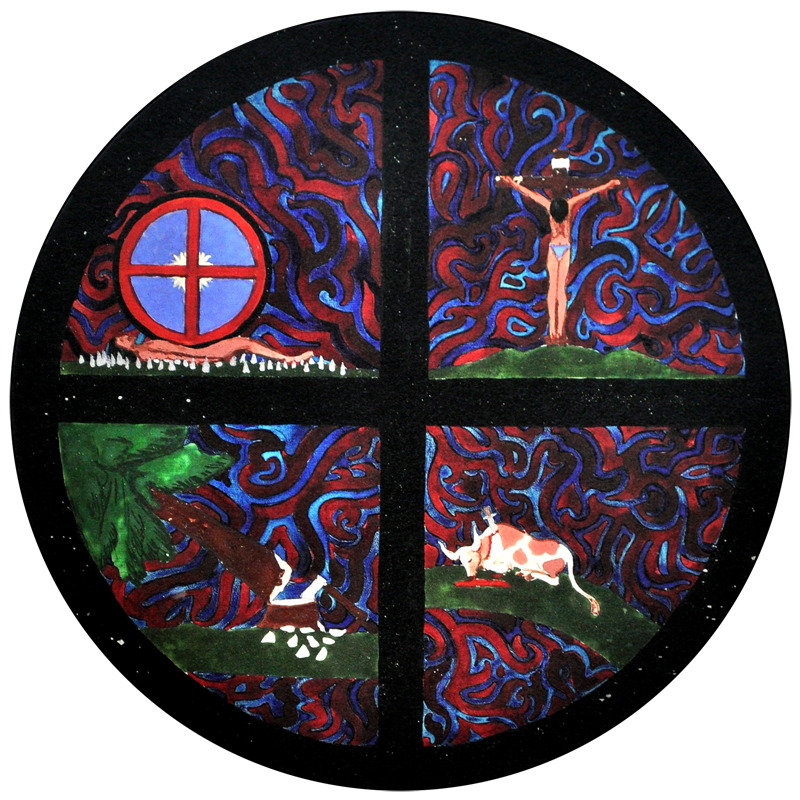In Christianity, a circle symbolizes God, because it has no beginning and no end. In older paintings which depict Christ, its’ common to see a circle of light behind Jesus’ head, to highlight his divinity. The word mandala is the Sanskrit word for circle or disk. The Christian Mandala™ then begins with God.
There is a Wikipedia article on mandalas, and it’s almost correct (I admit it, the professors were right) The article states: “We owe the re-introduction of mandalas into modern Western thought to Carl Jung.” Jung actually re-introduced the western, or non-traditional, mandala back into modern Western thought.
Carl Jung was a brilliant Swiss Psychiatrist. He’s also controversial.
Before we move forward we ask the big question: was Jung a Christian?
Going back to what I said in the introduction of this series of posts, I can’t look into Jung’s heart. I’m also not in a position where I can judge him. But Jung did leave behind plenty of evidence that suggests he was. At the very least, he was an important creator, and advocate of Christian mandalas – part of the fruit he bore for Christ.
The first piece of evidence: Jung professed to be a Christian.
In volume 18 of The Collected Works of C. G. Jung, called The Symbolic Life, Jung describes three attributes of his character. He starts by saying: “Firstly: Because I am a practical Christian to whom love and justice to his brother mean more than dogmatic speculations….” The first trait a person mentions when describing themselves is likely the most important to them. Before anything else, Jung refers to himself as a Christian.
There’s plenty of evidence to back the attribution of being a Christian to Jung. Jung’s father was a pastor, and Jung himself was baptized. After he died, Jung was buried in a Swiss, Protestant cemetery in in the village of Küsnacht, Switzerland. But Jung’s association with the faith was more than just being a PK. Jung wrote extensively on Christianity. A collection of these writings can be found in the book: Jung on Christianity (Encountering Jung).
Coming back to The Symbolic Life, Jung goes on to say: “Secondly: because I am a doctor.” Jung was trained in the field of medicine, and later went on to practice psychiatry. In both careers, Jung used his gifts to heal people. He desired “his brother” to be well, and free of disorder.
Finally, Jung states: “Thirdly: Because I am a man of science.” One of his great contributions to science was developing the concept that people have extraverted and introverted personality types. Kathrine Briggs and her daughter, Isabel Myers built upon Jung’s work to create the Myers-Briggs Test.
Re-introducing western mandalas was a psychological contribution. Jung wrote the book Mandala Symbolism, which is about western mandalas. The book is full of examples of western mandalas, some of which are Christian mandalas. There is a misconception that Jung introduced eastern mandalas to the West. This is not the case.
Eastern mandalas are traditionally drawn by a trained monk. Others then used the mandalas as a point of focus for eastern meditation. Eastern mandalas are popular in Tibetan Buddhism, Hinduism, and the New Age movement. Not Christianity.
Just as the concept of meditation differs between eastern tradition and Christianity (click here for more information), the concept of a western mandala is completely different than the eastern mandala.
Western mandalas are drawn by the individual who is reflecting on themselves, Scripture, God, Christ, or all of the above. They are a visual way to capture thought in the form of a circle. Jung took the concept of the western mandala, and used it in his practice to provide therapy for his patients.
The Christian mandala is a subset of the western mandala, where the focus is on Christ. Beginning with the circle, the Christian symbol for God is a good starting point when reflecting deeply on Scripture. Then, fill the inside of the circle with insights and understanding revealed by the Holy Spirit. A focus on Christ. A symbol of God. Insights from the Holy Spirit. A Christian practice.
The Christian practice of meditating on Christ, and drawing a mandala, has been performed by everyone in our top 10.
The mandala above was one of Jung’s, called Love Triumphs, and it depicts Jesus’ sacrifice. Regarding this mandala, he states: ““It expresses I know not what kind of grief, a fourfold sacrifice. I could almost choose not to finish it.”
At mandala’s center is a large black cross, dividing the mandala four ways. The black cross itself symbolizes Jesus’ death. There are four portrayals of this sacrifice: two of which include a man, and the remaining two contain a plant and an animal, respectively. At a deeper level, Jung had each portrayal based on the four functions of the conscious mind: thinking, feeling, sensing, and intuition. For example, the bottom right portion represents intuition, based on the comparison of the Levitical sacrifices to Jesus’ crucifixion. The use of all possible modes that humans can use to comprehend reality indicates a deep, emotional consideration of the sacrifice of Jesus.

